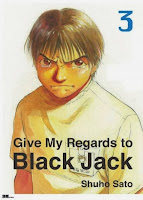Created by Shuho Sato
Having given the nod to Osamu Tezuka’s classic creation, Give My Regards to Black Jack goes in a different direction from its predecessor. While they both have a doctor as their main protagonist, the latter series is set in the more down-to-earth milieu of Japan’s healthcare system. The manga’s intent of exposing its flaws falls into familiar territory of the individual fighting a corrupt system. It’s a curious blend of serious social critique and manga tropes.
Author Shuho Sato front-loads the story with a bevy of statistics in order to impress on the reader the true scale of the country’s health care industry. Eight thousand students graduate from medical school annually and go on to become interns for two years at various teaching hospitals. Interns are overworked and underpaid, forcing many to take up part time jobs elsewhere despite a chronic lack of sleep. Our hero Eijiro Saito graduated from Eiroku University, the manga’s equivalent to Harvard, and is interning at the university hospital. The guy starts his career full of pep, boasting of surviving on only two hours of sleep a night. But he’s dirt poor, so he moonlights at the E.R. of an affiliated hospital. While there, his naive outlook is quickly shattered. He learns that the E.R. only accepts traffic accident victims due to a legal loophole that allows the hospital to overcharge to the patient’s insurance policy. Japanese hospitals are usually understaffed and Saito has to operate on patients he has no business treating without proper training. When he objects after being forced to deal with a particularly gristly accident victim, his immediate superior tells him “...if he’s got to die, you might as well cut his abdomen open...”
Things aren’t much better at Eiroku. Once his rotation training begins, he’s exposed to the unseemly underbelly of hospital administration. Surgical procedures are decided on dollars and cents as much as they are on the patient’s welfare. University professors are often revealed to be incompetent or indifferent doctors. Bureaucracy is often a hindrance and leads to interdepartmental conflict. It’s all pretty demoralizing. But what particularly offends Saito is the old boys network (Japanese medicine here is very much a male-dominated world) that informally links the nation’s hospitals to its medical schools, creating a kind of industry-wide web he disparagingly labels the “medical mafia.” Doctors obsessed with social climbing and prestigious positions often obscure the advancement of more qualified physicians.
None of this would be strange to people who regularly consume medical dramas. But Sato backs it up with liberal sprinklings of facts and figures. His storytelling has a certain muckracking quality, and for all I know he may have an axe to grind. With each department rotation, Saito gets involved in cases were his personal ethics often conflict with the orders of the department heads. These dilemmas seem grounded enough to be based on actual events. The hospital settings are lovingly rendered in detailed realism, which can be disconcerting to more squeamish readers when Sato illustrates several medical procedures. While I’m not qualified to comment on the accuracy of his research or the merit of his arguments, his characterizations often lack subtlety. Baby-faced Saito seems to only function through extreme moods, swinging wildly from joy to despair. In many ways, he’s your typical hot-blooded shonen protagonist. And the doctors can be distinguished by how they’re visually portrayed: The doctors Sato disagrees with all look haughty and a bit affected. The good doctors are naturally all rebels possessing rugged facial features which he loves to draw in extreme closeups just as they’re staring into the distance while wearing an expression of fierce determination.
Sato can sometimes be dismissive. Even when his antagonists put forth arguments that deserve a more considered response, he employs his art to present them as venal, condescending towards patients and subordinates, and self-serving. They’re the villains, they’re wrong, and Sato brooks no room for more nuanced take on the issues. A chapter showcasing a doctor running a private clinic as being a more dedicated caretaker than the staff at a large hospital is really no more sophisticated than the message found in Doc Hollywood.
Give My Regards to Black Jack is a flawed work. Its topical focus and heavy-handed approach isn’t going to appeal to everybody. While the art is accomplished, it's stiff and awkward, and can look gloomy and oppressive at times. And Saito isn’t a particularly well-rounded character. But to give Sato the benefit of the doubt, I’ve only reviewed the series' first three volumes. Its interesting that such a dissenting voice has managed to keep the series going and I’m curious to hear what people who are more informed about Japanese medicine would have to say about it.






